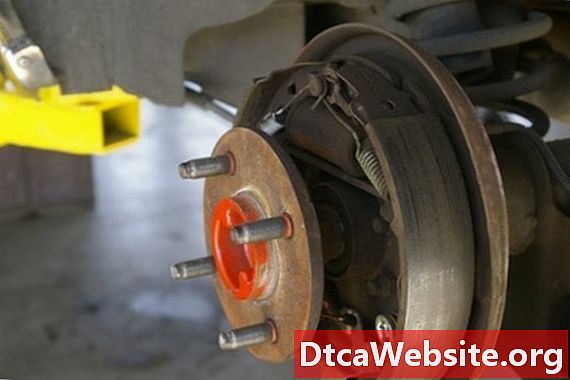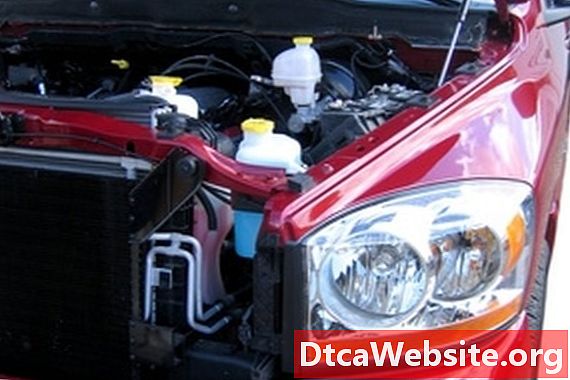
Contenu
- Removal
- Step 1
- Step 2
- Step 3
- Installation
- Step 1
- Step 2
- Step 3
- Step 4
- Step 5
- Step 6
- Tip
- Warnings
- Items you will need
The clutch used by your Yamaha Raptor 350 operates through friction generated by a spring-loaded stack of steel and fiber plates. When the clutch is engaged, these plates are pushed against a housing mounted on the end of the engines crankshaft. This transfers the engines power output to the transmission. When the clutch plates wear, they begin to slip against each other, causing a delay in power that affects the performance and safety of your Raptor. You should replace the clutch plates and their springs as soon as you feel the clutch slipping.
Removal
Step 1
Park your Raptor 350 on a flat, level work area. Remove the seat and unscrew the oil tank filler cap, located between the seat rails. Place a drain pan below the engine, then unscrew the drain plug from the bottom of the crankcase, using a 21 mm socket and a socket wrench. Allow the engine to drain completely, then screw the drain plug into place. Tighten the plug to 31 foot-pounds, using a torque wrench.
Step 2
Loosen the lower clutch cable adjuster lock nut, located on the clutch release arm on top of the right crankcase cover, using a 12 mm crescent wrench. Turn the cable adjuster clockwise to loosen the clutch cable, then pull the cable end out of the notch cut into the release arm. Turn the clutch release arm counterclockwise to release the inner clutch push rod. Remove the right crankcase cover and gasket, using a 5 mm Allen wrench or an 8 mm socket. The clutch assembly now will be exposed on the end of the crankshaft.
Step 3
Remove the clutch spring bolts, located at the center of the star-shaped outer clutch plate, using a 10 mm socket. Pull the clutch springs and the outer clutch plate off of the clutch assembly. Push the bearing and the clutch push rod out of the outer clutch plate.
Hold the clutch assembly in place, using a clutch holder tool. Remove the nut from the center of the clutch boss, the plate that retains the clutch plates, using a 19 mm socket. Pull the clutch boss and the clutch plates out of the clutch assembly. In total, there will be 13 clutch plates and two spring cushions in the stack of plates.
Installation
Step 1
Soak the new fiber and steel clutch plates in SAE 10W-30 SE-grade engine oil for 10 minutes.
Step 2
Slide the first four clutch plates into the clutch assembly in the following order: fiber plate, steel plate, fiber plate, steel plate. Place a new spring cushion over the last plate, then add four more plates in the same order. Place another cushion spring over the last plate, then install the remaining clutch plate in the same order, ending with the final fiber plate.
Step 3
Push the clutch boss over the clutch plates, aligning the boss spring wells with the spring posts on the inside of the clutch assembly. Hold the clutch assembly steady and tighten the clutch boss nut to 56 foot-pounds.
Step 4
Push the clutch push rod and bearing into the center of the outer clutch plate. Push new clutch springs over the spring pots, then place the outer clutch plate over the clutch springs. Screw the spring bolts into place and tighten them to 7.2 foot-pounds.
Step 5
Reinstall the right crankcase cover, then turn the clutch release arm clockwise until you feel resistance, indicating that the release arm has engaged the clutch push rod. Tighten the right crankcase cover bolts to 7.6 foot-pounds.
Step 6
Slip the end of the clutch cable into the clutch release arm. Turn the clutch cable adjuster counterclockwise to tighten the cable, then tighten the cable adjuster lock nut.
Unscrew the oil tank filler cap. Fill the oil tank with 2.5 quarts of engine oil, then screw the oil filler cap into place.
Tip
- A slipping clutch could also be caused by an over-tightened clutch cable, which holds the clutch in a semi-engaged position. Loosen the clutch cable and see if the slipping occurs again, before attempting to replace the clutch.
Warnings
- Do not ride your Raptor 350, if you suspect that the clutch is slipping. A slipping clutch is unreliable and can cause a loss of control, if the clutch slips then grips suddenly.
- Store used engine oil in a sealed container, away from the reach of children or animals, until it can be taken to your nearest Yamaha repair facility or auto parts store for disposal.
Items you will need
- Drain pan
- 8, 10, 19 and 21 mm sockets
- Socket wrench
- Torque wrench
- 3 quarts, SAE 10W-30 SE-grade engine oil
- 7 fiber clutch plates
- 6 steel clutch plates
- 3 spring cushions
- 5 clutch springs


